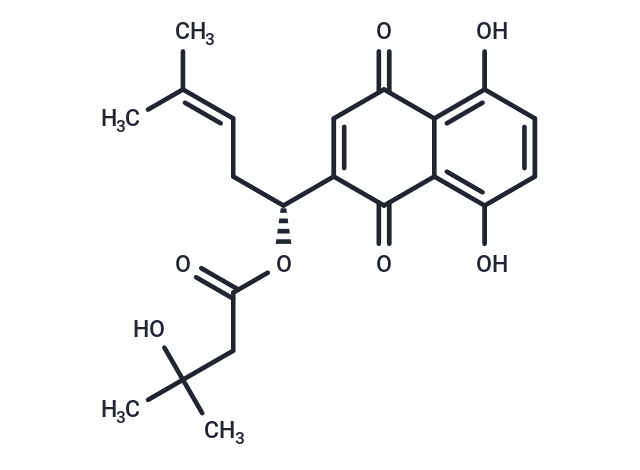Shopping Cart
- Remove All
 Your shopping cart is currently empty
Your shopping cart is currently empty

Beta-Hydroxyisovalerylshikonin is an inhibitor of protein-tyrosine kinases such as v-Src and EGFR, and has been shown to induce apoptosis in several human tumor cell lines. Beta-Hydroxyisovalerylshikonin significantly decreased viability of HCT116 cells (IC50 values = 30.9 μg/mL).

| Pack Size | Price | Availability | Quantity |
|---|---|---|---|
| 1 mg | $139 | In Stock | |
| 5 mg | $425 | In Stock | |
| 10 mg | $618 | In Stock | |
| 25 mg | $962 | In Stock | |
| 50 mg | $1,290 | In Stock |
| Description | Beta-Hydroxyisovalerylshikonin is an inhibitor of protein-tyrosine kinases such as v-Src and EGFR, and has been shown to induce apoptosis in several human tumor cell lines. Beta-Hydroxyisovalerylshikonin significantly decreased viability of HCT116 cells (IC50 values = 30.9 μg/mL). |
| Targets&IC50 | Viability:30.9 μg/mL, EGFR:0.7 microM, v-Src:1 microM |
| In vitro | By using different chromatographic techniques and appropriate spectroscopic methods, the seven naphthoquinones were described: deoxyshikonin ( 1 ), isobutyrylshikonin ( 2 ), α±-methylbutyrylshikonin ( 3 ), acetylshikonin ( 4 ), Beta-Hydroxyisovalerylshikonin( 5 ), 5,8-O-dimethyl isobutyrylshikonin ( 6 ) and 5,8-O-dimethyl deoxyshikonin ( 7 ). Among the tested compounds, 3 and 4 exhibited the highest antibacterial activities toward all tested bacterial species (MIC50 and MIC90 for gram positive bacteria: 6.40 μg/mL-12.79 μg/mL and 6.82 μg/mL-13.60 μg/mL, respectively; for gram negative bacteria: 4.27 μg/mL-8.53 μg/mL and 4.77 μg/mL-9.54 μg/mL, respectively). Also, naphthoquinones 3 and 4 exhibited strong cytotoxic activity against MDA-MB-231 cells (IC50 values 86.0 μg/mL and 80.2 μg/mL, respectively), while compounds 1 , 3 , 4 and 5 significantly decreased viability of HCT116 cells (IC50 values of 97.8 μg/mL, 15.2 μg/mL, 24.6 μg/mL and 30.9 μg/mL, respectively)[1] |
| Molecular Weight | 388.41 |
| Formula | C21H24O7 |
| Cas No. | 7415-78-3 |
| Smiles | CC(C)=CC[C@@H](OC(=O)CC(C)(C)O)C1=CC(=O)c2c(O)ccc(O)c2C1=O |
| Relative Density. | 1.312g/cm3 |
| Storage | Powder: -20°C for 3 years | In solvent: -80°C for 1 year | Shipping with blue ice. | |||||||||||||||||||||||||
| Solubility Information | DMSO: 10 mg/mL (25.75 mM), Sonication is recommended. | |||||||||||||||||||||||||
Solution Preparation Table | ||||||||||||||||||||||||||
DMSO
| ||||||||||||||||||||||||||

Copyright © 2015-2025 TargetMol Chemicals Inc. All Rights Reserved.